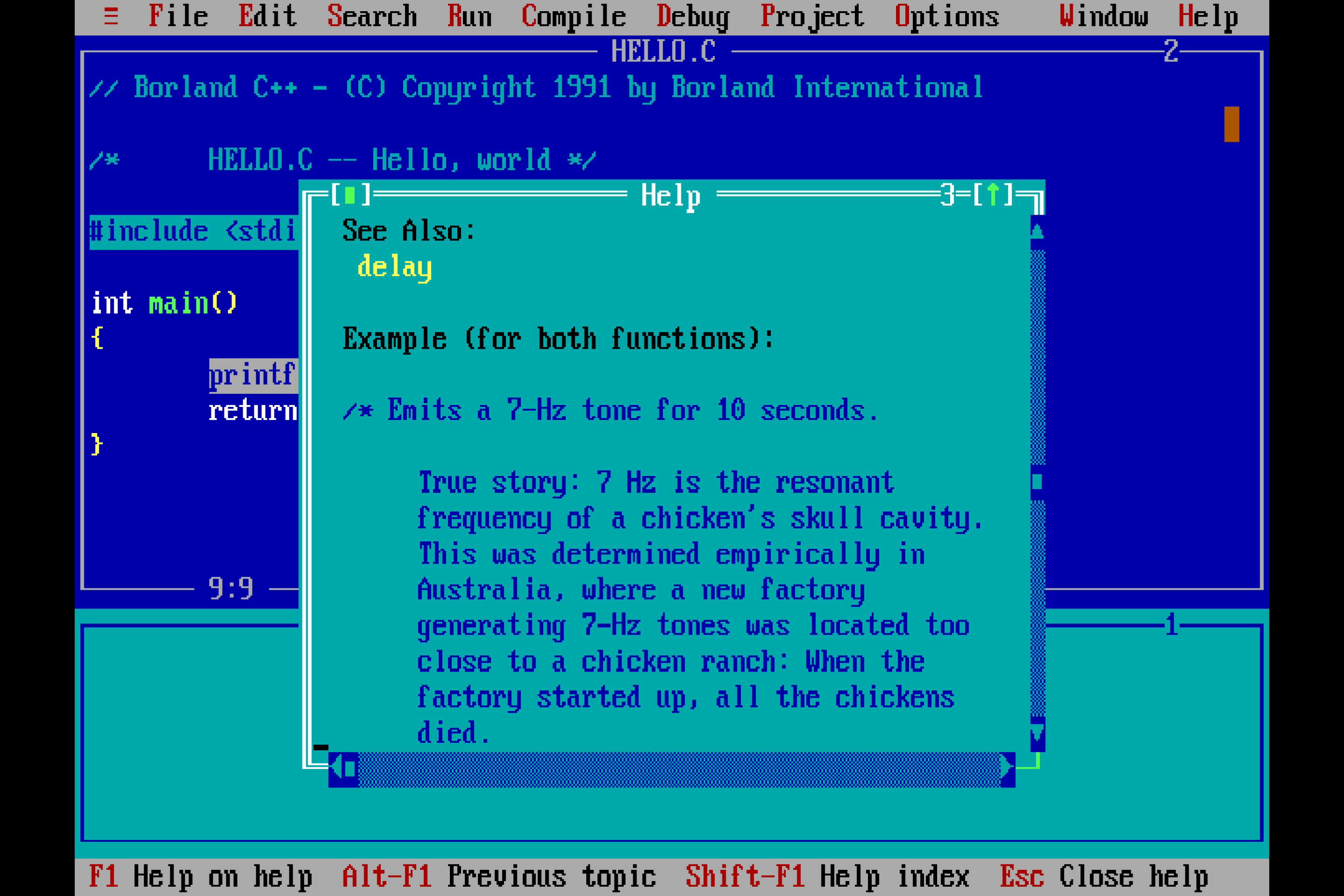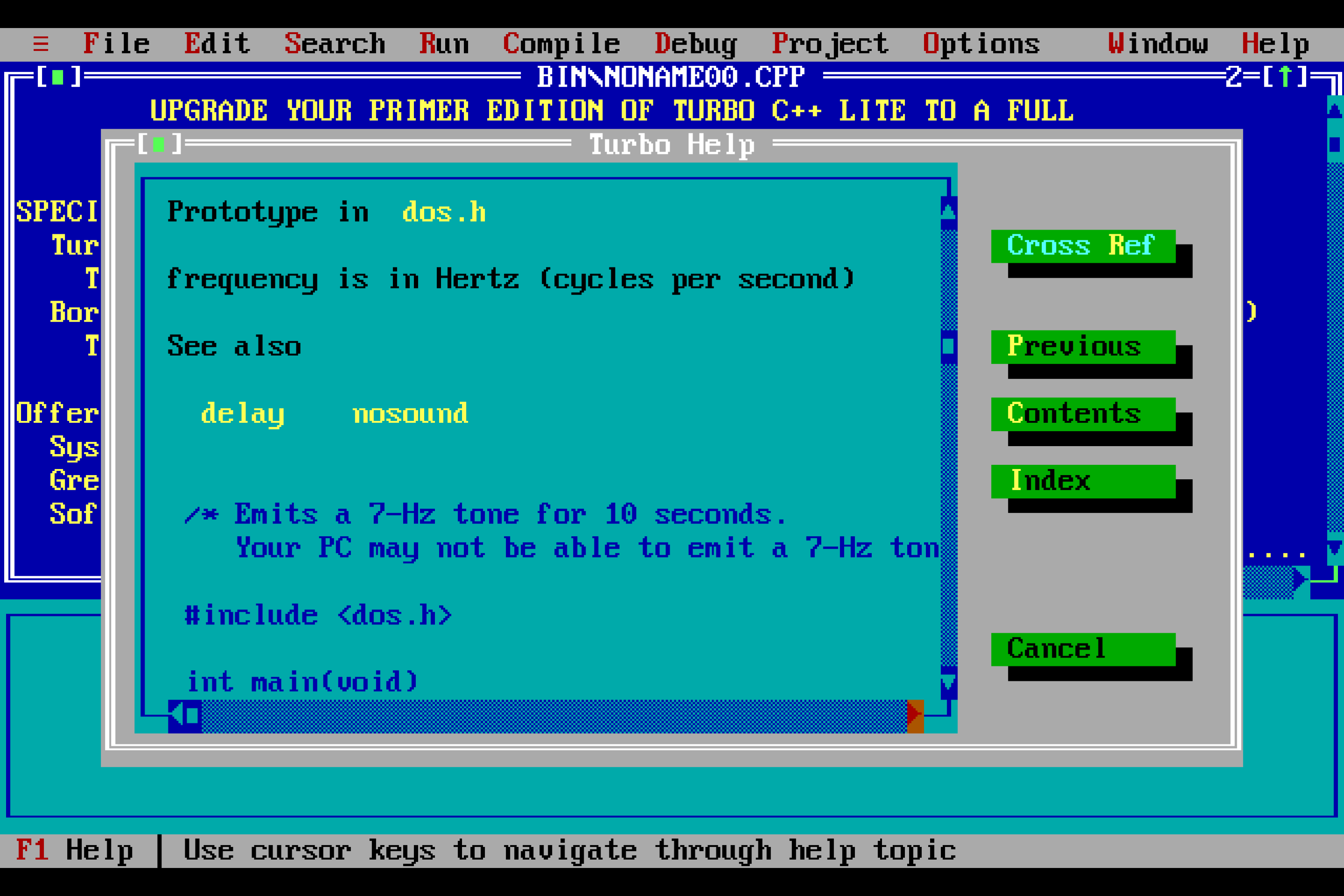For 33 years, a 'true story' about the 'resonant frequency of a chicken's skull cavity' written in an MS-DOS help file has fueled an urban legend that a certain sound wavelength will make chicken heads explode
Borland C++ Turbo, you've got some explaining to do.

Earlier this year, we relayed a story about how Janet Jackson's song Rhythm Nation just so happened to include the resonant frequency of 5,400 RPM 2.5-inch hard drives commonly used in laptops for many years. When played on (or even near) those laptops, the song would cause the drives to malfunction—and it was such a widespread problem that Microsoft incorporated code into Windows XP to filter out that particular frequency. Sounds unbelievable, but it's true! Audio experts, laptop makers and Windows developers all worked together to confirm the story—so when I was re-reading the 2022 Microsoft blog that first made the story news, I suddenly found myself wondering what other damage precisely the right (or, I suppose, wrong) sound frequency could do.
For example: Could you cause a chicken's head to explode with just the power of sound?
A comment on the 2022 blog casually suggests that perhaps such a thing is possible. "There is also the story of the resonant frequency of chicken skulls from the old Borland Turbo C++ documentation," it says. And it's not the only place on the internet you'll find reference to this story. In 2009, a Redditor on r/programming also linked to it, asking "7 Hertz Hurts? Is the Borland Turbo C++ documented story a myth or fact? Where are the Mythbusters when you need them?"
Another poster links to three now-dead Mythbusters forum threads where the question was raised. And it turns out this exact story has been going around for decades. Here's a thread on Stack Exchange from 2018. A debate on Hacker News from 2016. A Quora question from 2011. A programming forum post from 2001.
How the heck did the documentation for Borland's Turbo C++, a set of programming tools for MS-DOS, spawn an internet legend before the days of the internet? What, exactly, did it say? Just to make sure there hadn't been any hanky-panky with the spread of this story online over the years, I went looking on the Internet Archive to see for myself. I found an emulated copy of Turbo C++ 3.0, released in 1991, and dug through the help file. And in the help menu's explanation of the "sound" function, there it was:
"Emits a 7-Hz tone for 10 seconds.
"True story: 7 Hz is the resonant frequency of a chicken's skull cavity. This was determined empirically in Australia, where a new factory generating 7-Hz tones was located too close to a chicken ranch: When the factory started up, all the chickens died."
Keep up to date with the most important stories and the best deals, as picked by the PC Gamer team.
Some comments online from folks who remember this bizarre help apocrypha say the quote dates back to an earlier version in 1988, which is believable; it didn't last for too long, though, as I checked the 4.0 release of Turbo C++ from 1993 and discovered the help file had cleaned up its act and deleted the story. But that hasn't stopped it from echoing across the internet for decades, finding its way into actual true stories about Janet Jackson's music crashing laptop hard drives.
This was, of course, not "demonstrated empirically" in Australia sometime pre-1988. Borland's C++ software has a long history of Easter eggs, and the more mathematically and musically inclined online have explained pretty convincingly online why a tone of 7 Hz would not, in fact, liquify a chicken's brain inside its skull. But it's just too fun a "fact," shared in too unexpected a place, to resist sharing. In fact, it worked almost immediately.
In an archived 1992 newsgroup discussion on alt.folklore.computers, men with early access to the nascent internet were already trying to math it out.
"I really wish they had included a journal citation," wrote troberts from Georgetown University.
"No, the original article is garbage. The story is complete UL," wrote Bill Nelson from HP.
"Who would build a factory to produce 7 Hz tones? What's the market?" asked Tim Dierks, a software developer at Apple.
"Well, the military of course. No doubt some super secret project that blew its cover because of this flaw. I wonder what else resonates at this frequency," replied Markus Stumptner from the University of Technology Vienna.

Thankfully, after much debate, Ted Frank of the University of Chicago law school weighed in with some real scientific testing of his own, opting instead to bludgeon chickens to death with computers instead of sounds. He claimed that a Compaq 286 could kill a chicken in a mere three blows, while a Commodore VIC-20 was simply too light to get the job done in less than 53 swings.
"Disclaimer: No real chickens were harmed in the testing," Frank wrote. "Instead, robot chickens were developed at great expense, with the help of a grant from the L'Oreal corporation. For maximum reality, each of the systems were subjected to the frozen chicken cannon at the end of the testing, but none of the computers fared particularly well in this stage of the testing. Urban Legend Underwriters' Laboratory (ULUL) does not endorse any of the products tested today, nor does it accept advertising from any third parties."
Frank would go on to create the website ChickenOffset.com, where people could donate to pro-gay rights organizations every time they purchased a meal from Chick-Fil-A. He also advocated for class action lawsuit reform in front of the United States Supreme Court, some years after preparing an infamous vetting report for the John McCain campaign that ultimately convinced it to go with vice presidential candidate Sarah Palin. Frank insisted to GQ in 2013 the report was "exhaustive" and included "almost everything that would eventually dog her on the campaign trail."
In the made-for-TV film dramatization of the campaign, he was played by actor Brian d'Arcy James, best known for the role of Shrek in the Broadway production Shrek the Musical.

Wes has been covering games and hardware for more than 10 years, first at tech sites like The Wirecutter and Tested before joining the PC Gamer team in 2014. Wes plays a little bit of everything, but he'll always jump at the chance to cover emulation and Japanese games.
When he's not obsessively optimizing and re-optimizing a tangle of conveyor belts in Satisfactory (it's really becoming a problem), he's probably playing a 20-year-old Final Fantasy or some opaque ASCII roguelike. With a focus on writing and editing features, he seeks out personal stories and in-depth histories from the corners of PC gaming and its niche communities. 50% pizza by volume (deep dish, to be specific).
You must confirm your public display name before commenting
Please logout and then login again, you will then be prompted to enter your display name.



